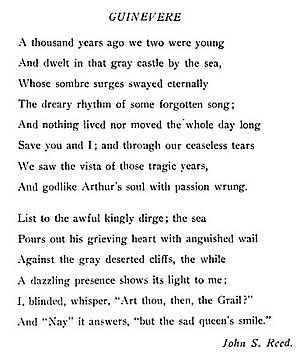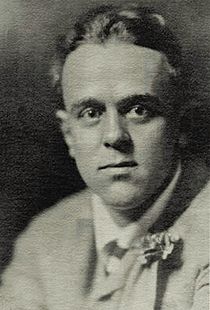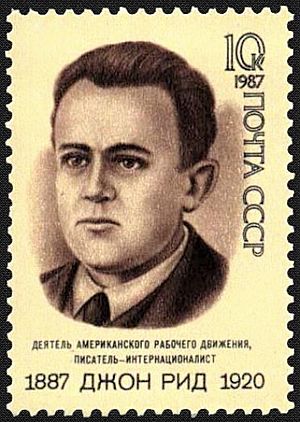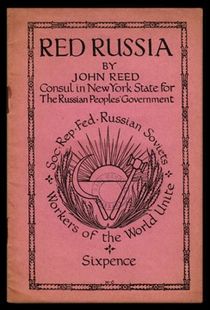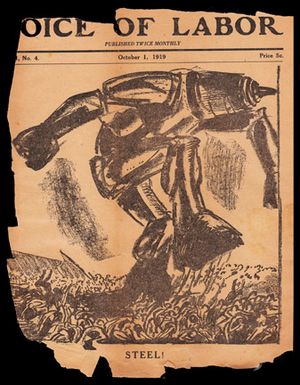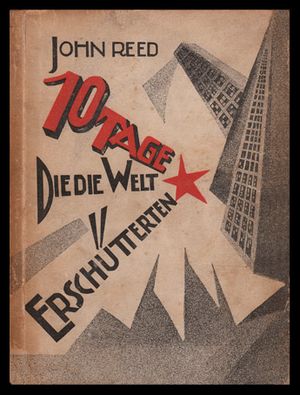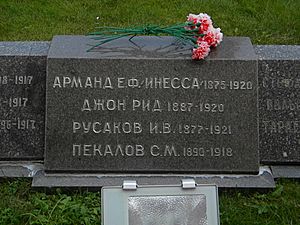John Reed (journalist) facts for kids
Quick facts for kids
John Reed
|
|
|---|---|
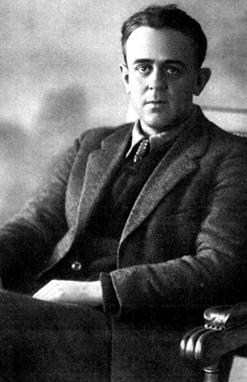
Reed c. 1915
|
|
| Born |
John Silas Reed
October 22, 1887 Portland, Oregon, U.S.
|
| Died | October 17, 1920 (aged 32) |
| Cause of death | Scrub typhus |
| Resting place | Kremlin Wall Necropolis, Moscow |
| Education | Harvard University |
| Occupation | Journalist |
| Political party | Communist Labor Party of America |
| Spouse(s) | |
| Signature | |
 |
|
John "Jack" Silas Reed (October 22, 1887 – October 17, 1920) was an American journalist, poet, and communist activist. He first became well-known as a war correspondent during the Mexican Revolution and World War I. He is most famous for his reports on the October Revolution in Russia. He wrote about this in his 1919 book Ten Days That Shook the World.
Reed supported the new Soviet government in Russia. He even joined the Red Guards for a short time in 1918. He hoped for a similar Communist revolution in the United States. In 1919, he helped start the Communist Labor Party of America. He died in Moscow in 1920 from a disease called spotted typhus. The Soviet Union gave him a hero's burial. He is one of only three Americans buried at the special Kremlin Wall Necropolis.
Contents
Early Life and Education
John Silas Reed was born on October 22, 1887, in Portland, Oregon. He grew up in a wealthy family with servants. As a child, he was often sick. He had a younger brother named Harry.
John and Harry went to a private school called Portland Academy. John was smart but did not work hard for top grades. He found school boring. In 1904, he went to Morristown, a prep school in New Jersey. This was to get ready for college. His father wanted his sons to go to Harvard. At Morristown, John still didn't do well in classes. But he played on the football team and showed talent for writing.
Reed got into Harvard University in 1906. He was tall, handsome, and cheerful. He joined many student activities. He was a cheerleader, on the swimming team, and in the drama club. He also wrote for student newspapers like the Lampoon and The Harvard Monthly. He was president of the Harvard Glee Club. He was also chosen as "Ivy orator and poet" in his last year.
Reed went to meetings of the Socialist Club. His friend Walter Lippmann led this group. They worked to improve conditions for university workers. They also asked the school to offer a course on socialism.
Reed graduated from Harvard in 1910. That summer, he traveled to England, France, and Spain. He worked on a cattle boat to pay for his trip. His favorite professor, Charles Townsend Copeland, told him to "see life" to become a good writer.
Becoming a Journalist
Reed decided to become a journalist. He moved to New York City, a big center for writing. He got help from Lincoln Steffens, a famous journalist. Steffens helped Reed get a starting job at The American Magazine. Reed also worked for a short time at a magazine called Landscape Architecture.
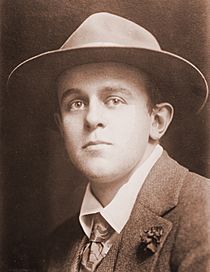
Reed lived in Greenwich Village, a neighborhood full of artists and writers. He loved New York and wrote poems about it. His jobs paid the bills, but he wanted to be a freelance journalist. He sent his writings to many places. Soon, his work was accepted by magazines like The Saturday Evening Post, Collier's, and The Century Magazine.
Reed became interested in social problems. In 1913, he joined the staff of The Masses, a socialist magazine. He wrote over 50 articles for them.
His first arrest happened in Paterson, New Jersey, in 1913. He was trying to speak for workers on strike at silk mills. The police treated the strikers badly. This made Reed even more radical. He supported the Industrial Workers of the World, a union. He wrote about his experience in an article called "War in Paterson." He also helped put on a play about the strike in Madison Square Garden.
Reporting on Revolutions and Wars
In late 1913, Metropolitan Magazine sent Reed to Mexico. He was to report on the Mexican Revolution. He spent four months with Pancho Villa's army. He saw them defeat Federal forces at Torreón. Reed admired Villa very much.
His reports on the Mexican fighters made him famous as a war correspondent. Reed felt great sympathy for the poor farmers. He was strongly against American involvement in Mexico. His reports were later published as the book Insurgent Mexico (1914).
In April 1914, Reed went to Colorado. There had been a terrible event called the Ludlow massacre. This was part of a war between coal miners and a company owned by John D. Rockefeller, Jr.. Reed spent a week there. He investigated the events and spoke for the miners. He wrote a powerful article called "The Colorado War." This experience made him believe even more in the idea of class conflict.
In August 1914, Reed sailed to Italy for the Metropolitan magazine. Germany had just declared war on France. Reed believed the war was caused by countries fighting over trade. He didn't support any side.
In France, Reed found it hard to report because of censorship. He then went to Berlin. There, he interviewed Karl Liebknecht, a socialist who voted against the war. Reed was sad that workers around the world were not united. Instead, they were filled with militarism and nationalism.
He returned to New York in December. In 1915, he traveled to Central Europe with artist Boardman Robinson. They saw terrible destruction in Serbia. They were arrested in Chełm and held for weeks. They were almost shot for being spies. The American ambassador saved them.
When they went to Russia, the American ambassador in Petrograd also thought they might be spies. They were arrested again when trying to enter Romania. Finally, they were allowed to leave, but their papers were taken. Reed wrote a book about these experiences called The War in Eastern Europe (1916).
After returning to New York, Reed met Louise Bryant in Portland. They fell in love. In 1916, they rented a cottage in Provincetown, Massachusetts, with playwright Eugene O'Neill. Reed married Bryant in November 1916. He also had surgery that year. This made him unable to be drafted into the army.
As the U.S. got closer to war, Reed lost his job with Metropolitan. When President Woodrow Wilson asked for war in April 1917, Reed strongly spoke against it. He said, "This is not my war, and I will not support it." He continued to write articles against the war for The Masses. Because of these articles, the magazine lost its funding and stopped publishing. Reed was shocked by how much the country supported the war. His career seemed to be ruined.
Witnessing the Russian Revolution
On August 17, 1917, Reed and Bryant sailed to Europe. They told the State Department they were going as journalists. They wanted to report on the big changes happening in Russia. They arrived in Petrograd after a failed military attempt to overthrow the government. Russia's economy was in chaos.
Reed and Bryant were in Petrograd for the October Revolution. In this event, the Bolsheviks, led by Vladimir Lenin, took power. The Bolsheviks believed this was the start of a worldwide socialist revolution.
There was not enough food in the capital, and society was very disorganized. People wanted big changes. The Bolsheviks wanted a government run by socialists. They also wanted Russia to leave the war right away. They wanted power to go to a Congress of Soviets. This was a meeting of elected workers' and soldiers' representatives.
The government tried to stop the Bolsheviks. But a special committee of the Soviets decided to take power. On November 7, 1917, they captured the Winter Palace. This was where the government met. Reed and Bryant were there when the Winter Palace fell. This was the start of the Bolshevik Revolution.
Reed strongly supported the new government. He worked for the new People's Commissariat for Foreign Affairs. He translated the new government's rules and news into English. He also helped gather information for German soldiers.
Reed was close to the new leaders. He met Leon Trotsky and Vladimir Lenin. In December, he was running out of money. He took a job with the International Red Cross. They wanted to start a newspaper to promote American interests. Reed added a warning to the paper. It said, "This paper is devoted to promoting the interests of American capital."
In January, Trotsky offered Reed a job as the Soviet Consul in New York. But the United States did not recognize the Bolshevik government. So, Reed would likely have been arrested. Lenin later withdrew the offer.
Reed and Bryant wrote books about their time in Russia. Bryant's book was Six Red Months in Russia. Reed's book, 10 Days That Shook the World (1919), became very famous.
Bryant went back to the United States in January 1918. Reed did not get back to New York City until April 28. On his way back, he traveled through Finland. Finnish police arrested him in Turku harbor. He was held in Kakola prison. He then traveled to Norway and Sweden.
When his ship reached New York, federal officers met him. They searched his belongings for eight hours. They took his papers, which he needed for his book. He was released, but his papers were not returned until November.
Activism and Final Journey
Back in America, Reed and Bryant defended the Bolsheviks. They were against America getting involved in Russia. People were angry that Russia left the war against Germany. So, Reed was not welcomed. He had written articles against the war for The Masses. These articles led to the government charging the magazine with sedition.
Reed was arrested several times for his speeches and writings. He was charged with inciting a riot and violating the Sedition Act. He passionately defended the Russian Revolution. He believed a similar revolution might come to America.
In 1919, Reed was part of the Socialist Party. He and other radicals were kicked out of a meeting in Chicago. The radicals then split into two groups. Reed helped create the Communist Labor Party of America. He wrote its plans and edited its newspaper, The Voice of Labor. Reed's writings from 1919 showed he had doubts about Western-style democracy. He defended the idea of a "dictatorship of the proletariat." He thought this was a necessary step to reach true democracy.
Working for the Comintern
Reed was charged with sedition. He wanted to get support for his party from the Comintern (Communist International). So, he left America in October 1919 with a fake passport. He worked on a ship to Norway. From there, he traveled through Sweden and Finland to Moscow.
In Moscow, he observed factories and villages. His feelings about the revolution became mixed. He met Emma Goldman, an activist who had been sent away from the U.S. Goldman was worried about the Cheka, a secret police force. Reed told her that enemies of the revolution deserved their fate. But he also suggested she talk to a critic of the situation.
Reed tried to return to the United States in February 1920. He tried to leave Russia through Latvia, but his train didn't arrive. He then hitched a ride to Petrograd. In March, he crossed into Finland. His friends helped him hide on a freighter ship.
On March 13, Finnish customs officials found Reed hiding in a coal bunker. He said he was a seaman named "Jim Gormley." But the jewels, photos, and fake papers he had forced him to reveal his true identity. He refused to name his contacts. He was charged with smuggling and having jewels. He was fined, but still held.
Reed's health and mood got worse. He suffered from depression and insomnia. He wrote worried letters to Bryant. He was finally released in early June. He sailed to Estonia and then traveled to Petrograd. He was recovering from not having enough food and from scurvy. But his spirits were high.
At the end of June, Reed went to Moscow. He talked with Bryant about her joining him. She arrived in Sweden in August. At the same time, Reed attended the second Comintern congress. He was cheerful, but his body looked tired.
During this meeting, Reed argued with the Russian leaders. They believed the wave of revolution was slowing down. They thought the Communist party needed to work within existing systems. Reed felt this would be a disaster. He disliked the harsh tactics of Karl Radek and Grigory Zinoviev. They ordered Reed to go to a congress in Baku.
The trip to Baku was long, five days by train. The countryside was damaged by civil war and typhus. Reed did not want to go. He wanted to meet Bryant in Petrograd. But Zinoviev insisted he take the official train. Reed went, needing the Soviets' support. His friend Benjamin Gitlow later said Reed became very disappointed with the Communist movement because of how Zinoviev treated him.
In Baku, Reed got a telegram that Bryant had arrived in Moscow. He followed her there, arriving on September 15. He told her about the past eight months. He looked older, and his clothes were torn. In Moscow, he took Bryant to meet Lenin, Trotsky, and other Bolshevik leaders. They also visited Moscow's ballet and art galleries.
Death and Legacy
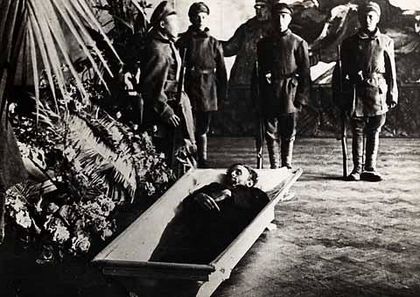
Reed wanted to return to the United States. But he fell ill on September 25. At first, doctors thought it was influenza. Five days later, he was diagnosed with spotted typhus. Bryant stayed with him, but there were no medicines because of a blockade. Reed's mind began to wander. He lost the use of his right side and could no longer speak. His wife was holding his hand when he died in Moscow on October 17, 1920. After a hero's funeral, Reed was buried in Mass Grave No. 5 at the Kremlin Wall Necropolis. He was buried next to Inessa Armand. Only three Americans have been given this honor. The other two are C. E. Ruthenberg and Bill Haywood.
How John Reed is Remembered
John Reed is remembered in different ways. For the Communist movement, he became a symbol of the worldwide Bolshevik revolution. He was seen as a hero buried in a special place. His name was spoken with great respect. Others, like his old friend Benjamin Gitlow, said that Reed had started to dislike the Soviet government near the end of his life. They tried to use Reed's story to support their own anti-communist ideas.
John Reed in Movies and Books
- The 1927 silent film October: Ten Days That Shook the World was based on Reed's book.
- John Dos Passos wrote a short biography of Reed in his 1932 novel 1919.
- The 1958 Soviet film In October Days showed Reed and Bryant.
- Actor and director Warren Beatty made the film Reds (1981) about Reed's life. Beatty played Reed, Diane Keaton played Louise Bryant, and Jack Nicholson played Eugene O'Neill. The movie won three Academy Awards.
- Two films are based on Reed's accounts of the Mexican Revolution. Mexican director Paul Leduc made Reed: Insurgent Mexico (1973). A Mexican–Soviet-Italian film called Red Bells (1982) and Red Bells II (1983) also featured Reed. Franco Nero played Reed in these films.
See also
 In Spanish: John Reed para niños
In Spanish: John Reed para niños


